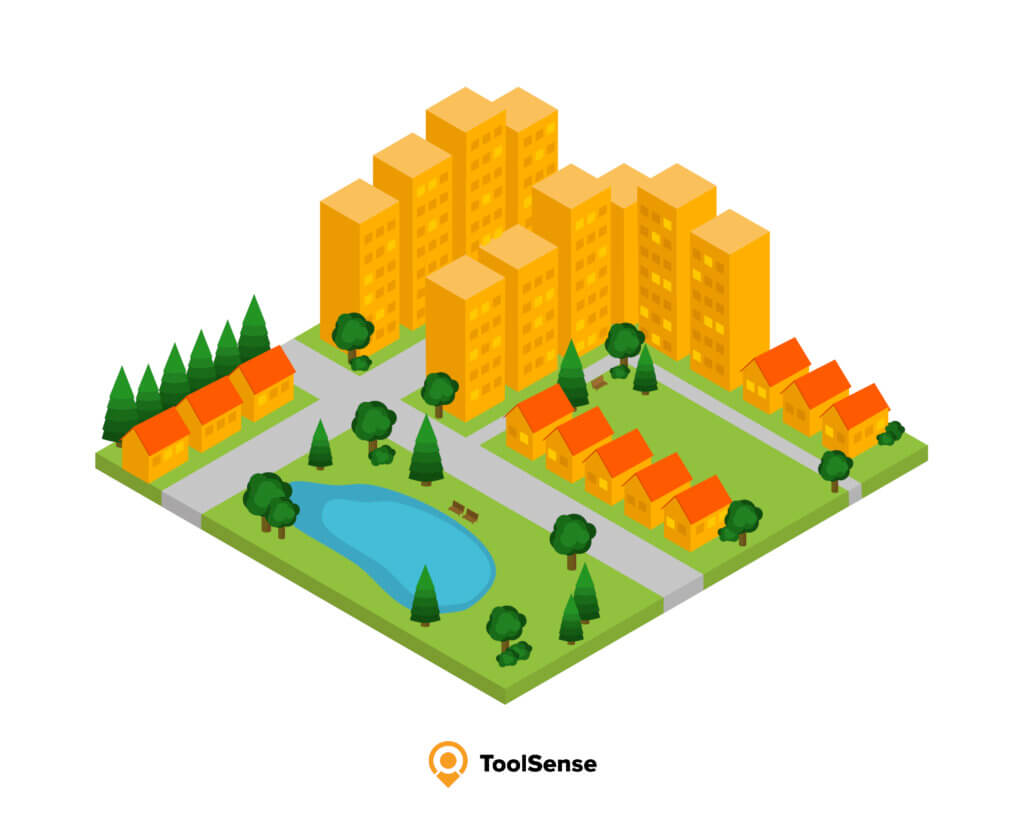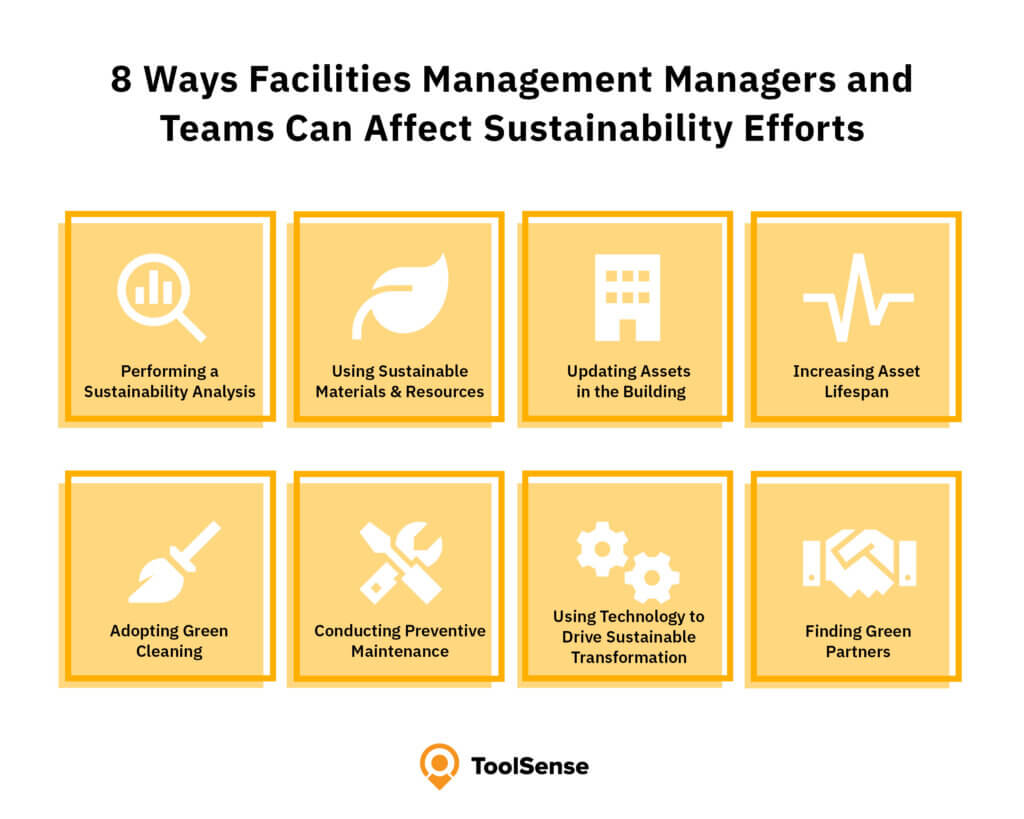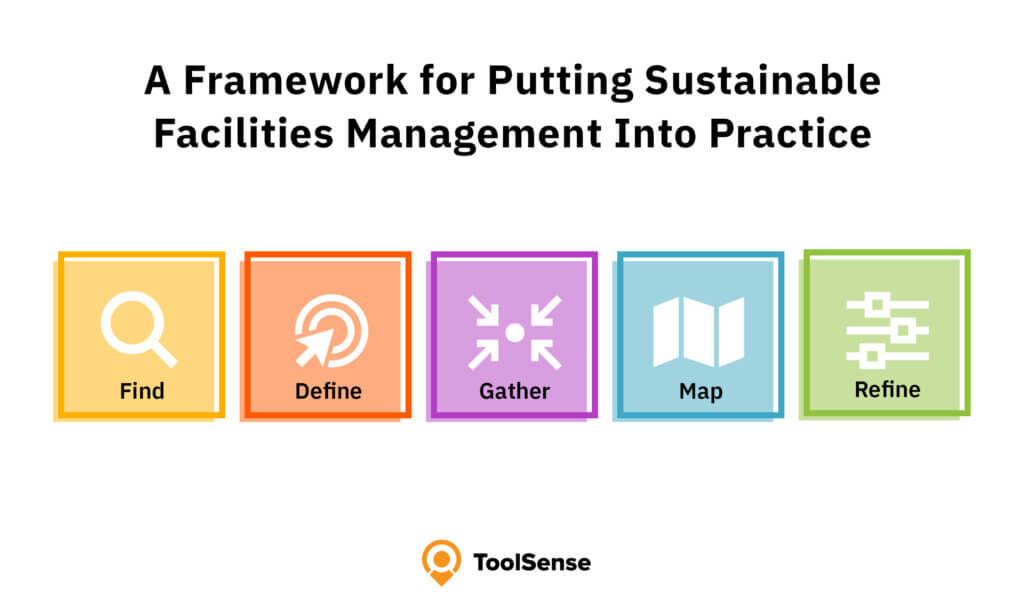Everybody is talking about climate change, swapping out fossil fuels in favour of renewable energy sources, and living a more sustainable lifestyle. Most of the time, a company’s carbon footprint is bigger than that of an individual, which is why it’s so important for businesses to start working towards a more sustainable workplace. Not only will it have a positive impact on the environment, but it will also contribute to happier employees and financial gains. Sustainable facilities management is a great place for companies to start fighting climate change.

Key Takeaways
- Sustainable facilities management describes a workplace that has a minimal or positive impact on the environment.
- Sustainability goals can be achieved by reusing and recycling materials, reducing energy and water usage, lowering carbon emissions and waste, and utilising renewable energy sources.
- The benefits of sustainable facility management solutions are lower costs, talent retention, an increase in productivity, a reduced carbon footprint, and an improvement of your brand reputation.
- ToolSense, a digital facility management solution, can help companies achieve their sustainability goals by managing assets, inventory, and more.
What Is Sustainable Facilities Management and Why Is It So Important?
The goal of sustainable facility management is to create a workplace that has a minimal, neutral, or even positive impact on the environment. This is generally achieved through waste reduction, and reusing or recycling resources and materials. Sustainable facilities management often requires a change in daily operations and the structure of the building as well. However, the use of smart technology can oftentimes be used as an alternative to making changes to the building’s architecture. Sustainability in facilities management doesn’t just affect the building itself, but the entire organisation and the people working for it, making sustainability efforts a comprehensive project.
The importance of sustainability in facilities management shows in an up to 60% boost in operational profits, better retention of talent, a smaller carbon footprint, and much more.
If you want to learn more interesting facts, read our article about “Facility Management Statistics 2022”.
Benefits of Sustainable Facility Management for Buildings, People, and Your Business
For Buildings
Lowering a Company’s Carbon Footprint
Energy constitutes a large portion of a business’s carbon footprint. The building itself consumes about 40% of a company’s energy and 55% of its electricity. According to estimations, 40% of that energy is lost, requiring more sustainable facility management solutions. To achieve sustainable FM, managers will sometimes find the root cause in their energy usage data and lower energy consumption if possible. Other times, energy consumption cannot be brought down due to outdated technology, in which case the installation of – for example – a more efficient HVAC system becomes necessary. Alternatively, businesses can install renewable energy sources to tackle the problem and benefit from a smaller carbon footprint.
Reduction of Costs
Exchanging fossil fuels for renewable energy sources and installing cutting-edge technology to reduce carbon emissions and electricity use might seem counterintuitive if a company’s goal is to save money. However, sustainable initiatives such as these have a fantastic return on investment. Green buildings show 20% fewer maintenance costs than regular buildings. Additionally, as prices for fossil fuels rise, prices for renewable energy sources, such as solar power or wind power, keep decreasing, making sustainably managed buildings more profitable in the long run.
For People
Increase in Productivity
Facility management has a great impact on the workplace environment and that, in turn, influences employee productivity. According to a Cornell University study, employees made far fewer typos when the room temperature was set between 20 and 25 °C. Workers experienced less stress in an environment where the air humidity was between 30 and 60%. Another study conducted by Harvard University also found that poor air quality due to high amounts of CO₂ affected employees’ cognitive function, health, and well-being negatively. Temperature, humidity, and air quality can be easily measured with smart sensors and adjusted accordingly as part of your facility management sustainable practices.
Talent Retention
Satisfied employees are less likely to quit, which is how sustainable facilities management can contribute to talent retention as well. This satisfaction goes beyond pay and workplace atmosphere because 66% of people asked by Harvard Business Review stated that they favoured an employer that had their health and well-being in mind. Additionally, when it comes to hiring new staff, younger generations tend to favour companies that allow hybrid working and show corporate social responsibility.
ToolSense is trusted by 700+ companies



For Organisations
Social Responsibilities
Apart from the positive impact sustainable facility management can have on employees, the environment, and a company’s budget, it can also contribute to a better community. According to an Australian study, green buildings can lower the temperature in a city by 2 °C, creating a better atmosphere for everyone in the area. It only requires a business to cover 7% of the building’s roof with greenery. Additionally, as consumer habits have changed in recent years, customers now prefer more sustainable alternatives and are willing to spend more money when buying from sustainable companies.
Return on Investment
Investing in a facilities management that is sustainable brings a company only advantages: increased productivity, decreased employee turnover, reduction of energy costs, and a better reputation. Because of this, any investment in sustainable facilities management comes with a high return on investment. As potential investors also take a company’s sustainability into account, it will be easier to attract new investors and retain the ones that are already investing in a business.
8 Ways Facilities Management Managers and Teams Can Affect Sustainability Efforts
Performing a Sustainability Analysis
The first step to better facilities management and sustainability should be to conduct a sustainability analysis to find what areas of your facilities management need improvement in the future. Your facilities management team might find an increase in carbon emissions, higher than normal water usage, or inefficient electrical devices by looking at utility bills and energy usage. Once you have gathered enough information, you can set new, more sustainable targets and develop a plan for how they can be reached.
Using Sustainable Materials and Resources
When it comes to creating more sustainable buildings, the choice of materials and resources plays a big role. It is your job as a facilities manager to ensure that the company’s resources consist of environmentally friendly materials and originate from sustainable vendors.

Updating Assets in the Building
Outdated assets can dent your company’s electrical bill, contribute to energy loss, and cause a larger overall carbon footprint. Even if the assets are still functional, it is often wise to replace them with a newer, more energy-efficient model to save money in the long run. This can include the installation of new HVAC units, motion light sensors, or better insulation.
Increasing Asset Lifespan
If your company already owns energy-efficient, modern assets, the goal in sustainable facility management should be to increase their lifespan. Keeping them in the best shape possible and favouring repair over replacement can save your company resources and money.
Adopting Green Cleaning
Sustainable facilities management services also include cleaning, which is vital for a company to function properly. Green cleaning is about more than merely swapping regular cleaning supplies for more environmentally friendly alternatives. It takes the environment as well as the health and well-being of all employees into account when it comes to choosing the right materials.
You can find more interesting key facts in our article about “sustainability in the cleaning industry”.
Conducting Preventive Maintenance
In facilities management and sustainability, preventive maintenance takes priority as part of the overall sustainability efforts. By taking care of existing equipment throughout its entire lifecycle and repairing it rather than buying a replacement, a company can save money and resources in one step. Faulty equipment might even use more energy, which is why regular maintenance tasks are important to uncover flaws in time.
Using Technology to Drive Sustainable Transformation
The right technology can help you reach your sustainability targets. By implementing facilities management software, such as ToolSense, you can keep an eye on all your assets, including their location, runtimes, downtimes, operational costs, and work orders, and ensure that they are in working order. This helps with preventive maintenance tasks and makes it easier to identify obsolete or inefficient assets. Additionally, it aids in your inventory management and prevents the waste of important resources.
Finding Green Partners
Not just the building or production process can have an impact on the environment – the same goes for the supply chain and procurement. Finding green parents is one of the best sustainable facility management operational strategies for today as sustainability issues can be solved at the root by buying from green suppliers and vendors.

A Framework for Putting Sustainable Facilities Management Into Practice
1. Setting the Mission
Sustainable facilities management is a team effort – not just the job of a single facilities manager. To reach your goals and create more sustainably managed buildings, all employees must be educated on how they can do their part. This can range from utilising natural light whenever possible to the correct ways to recycle materials. Creating achievable sustainability goals for everyone and communicating them to your team is the first step to a successful mission and building a green team.
2. Defining the Baseline
The road to sustainable facility management can be a long one, depending on where you start out. However, it is important to know where your company’s baseline is in terms of energy consumption, waste, water usage, and renewable energy sources to create a successful and achievable plan. Take a look at the impact your business and your suppliers have on the community and the environment, and create an overview that will serve as a baseline for your plans.
3. Defining KPIs and Developing a Roadmap
Once you know where your company stands in terms of sustainability in facilities management, you can begin to set your SMART goals. In this case, SMART stands for specific, measurable, attainable, relevant, and time-bound. Because sustainability is not an achievement that can be reached overnight, it is recommended to create a step-by-step plan with several smaller intermediate targets instead of an immediate net-zero target. These smaller targets can boost motivation for the entire green team.
4. Action
Once the goals have been set, you and your team can actively work towards reaching them. Depending on which goals you have set, it can include recycling and reusing materials, conducting regular preventive maintenance checks, using natural light instead of electricity, installing solar panels, exchanging chemical for natural cleaning products, implementing hybrid working, and much more.
5. Measuring Your Success
To ensure that you are not missing your goals, it can be wise to appoint a facilities manager that is responsible for tracking and documenting your success. These figures can be put in monthly or annual reports and compared to your company’s initial values and sustainability targets. Not only can this help you keep an eye on your overall progress, but it also serves as motivation for all team members to work towards reducing your carbon footprint.

Conclusion
Everyone is aiming for a more sustainable lifestyle – so it only makes sense that businesses, that are responsible for most of the carbon emissions and use up most of the fossil fuels, adopt a more environmentally friendly mindset as well. This can be done in smaller and larger steps, such as relying more on natural light than electricity or installing solar panels to utilise renewable energy sources. While these changes might seem daunting for many hesitant companies, they also come with great benefits not just for the environment, but for employees and the business’s budget, too. Increased productivity, retention of talent, a smaller carbon footprint, and the improvement of a company’s social value and brand reputation. Above all, however, sustainability efforts offer a great return on investment, which shows in lowered energy costs and attraction of investors.
Many companies need help putting their sustainability plans into action, which is where ToolSense can help. The digital facilities management solution allows for easy asset tracking and management. Location, runtimes, downtimes, maintenance history, audit reminders, and work orders can be tracked and organised with the help of this software. The useful reporting tools make it especially easy to get an overview of where your company stands in terms of its sustainability targets. Inventory management supports waste reduction and helps your company save money in the long run. Because ToolSense is a cloud-based service, important information can be easily accessed and documented from anywhere with a computer, tablet, or smartphone – and it creates a handy tool for remote and hybrid work models. That way, your company receives a fantastic overview of all assets and the entire inventory, which makes it a lot simpler to create a sustainable workplace.
ToolSense is trusted by 700+ companies



FAQ
Sustainable facility management focuses on creating a workplace that has a minimal or even neutral impact on the environment. If done correctly, the impact can also be positive – for example, by creating green buildings that combat some of the side effects of climate change.
The utilisation of renewable energy sources, the use of smart technology, and overall waste reduction are some of the most popular ways to create more sustainable facilities.
Focusing on sustainable practices can increase productivity, reduce employee turnover, improve a company’s social value and brand reputation, and lower monthly energy costs. This makes sustainability retrofit and facilities management a benefit for the environment as well as the company.
Sustainable facilities management can be divided into four key areas: waste management & recycling, targets & reporting, carbon footprint, and health & safety.




